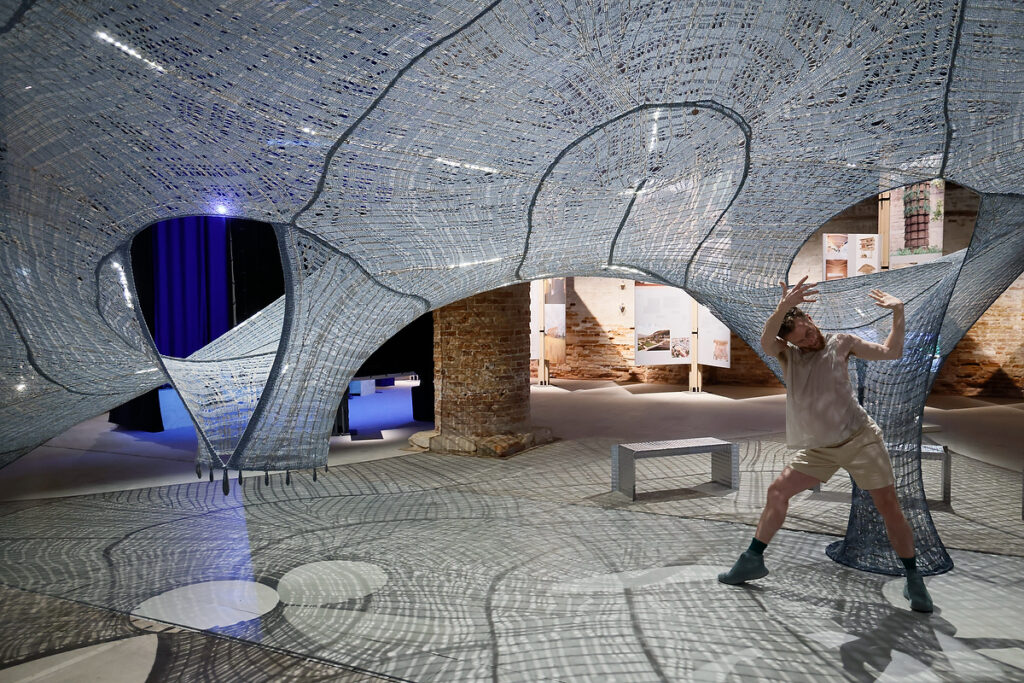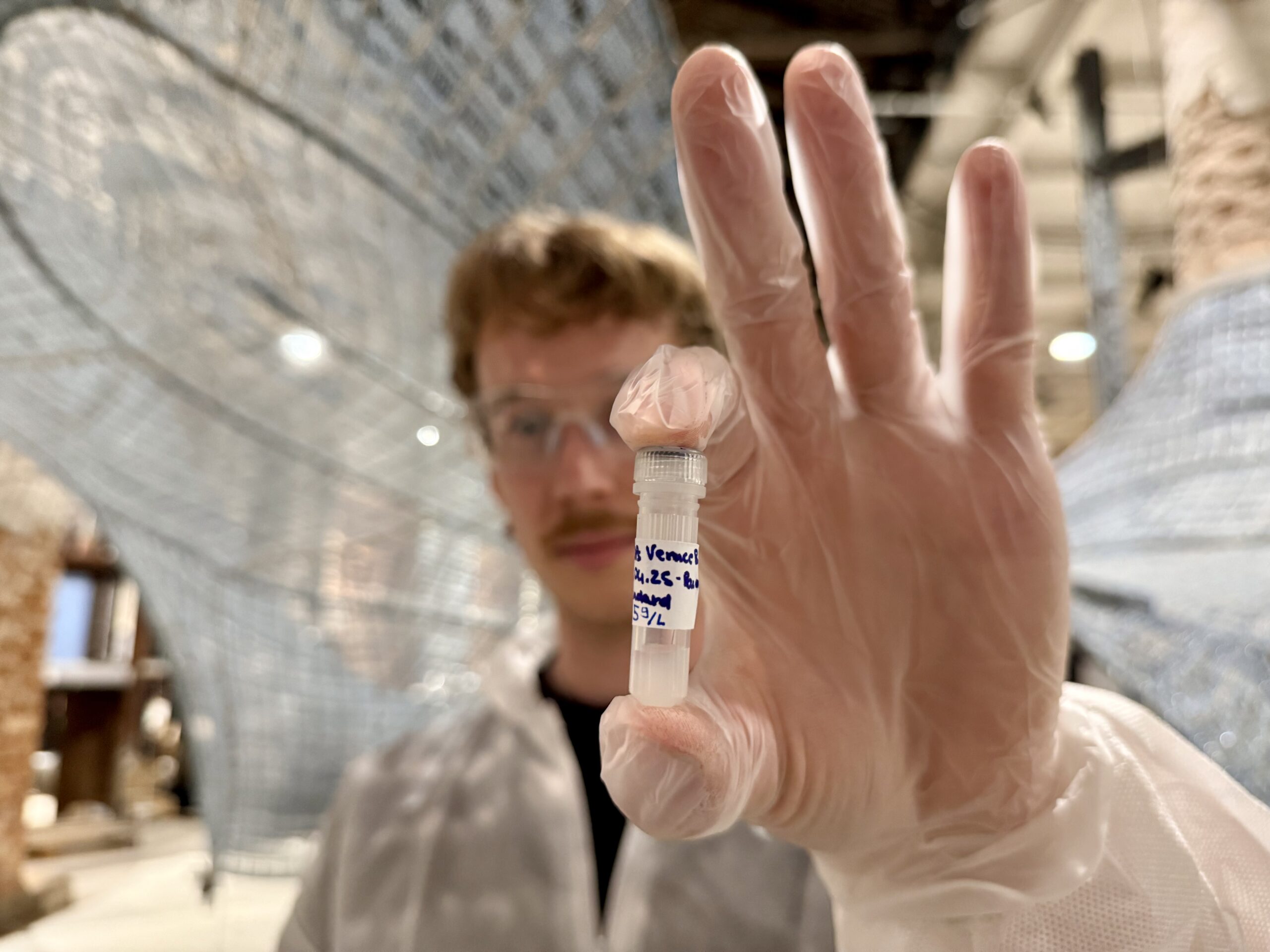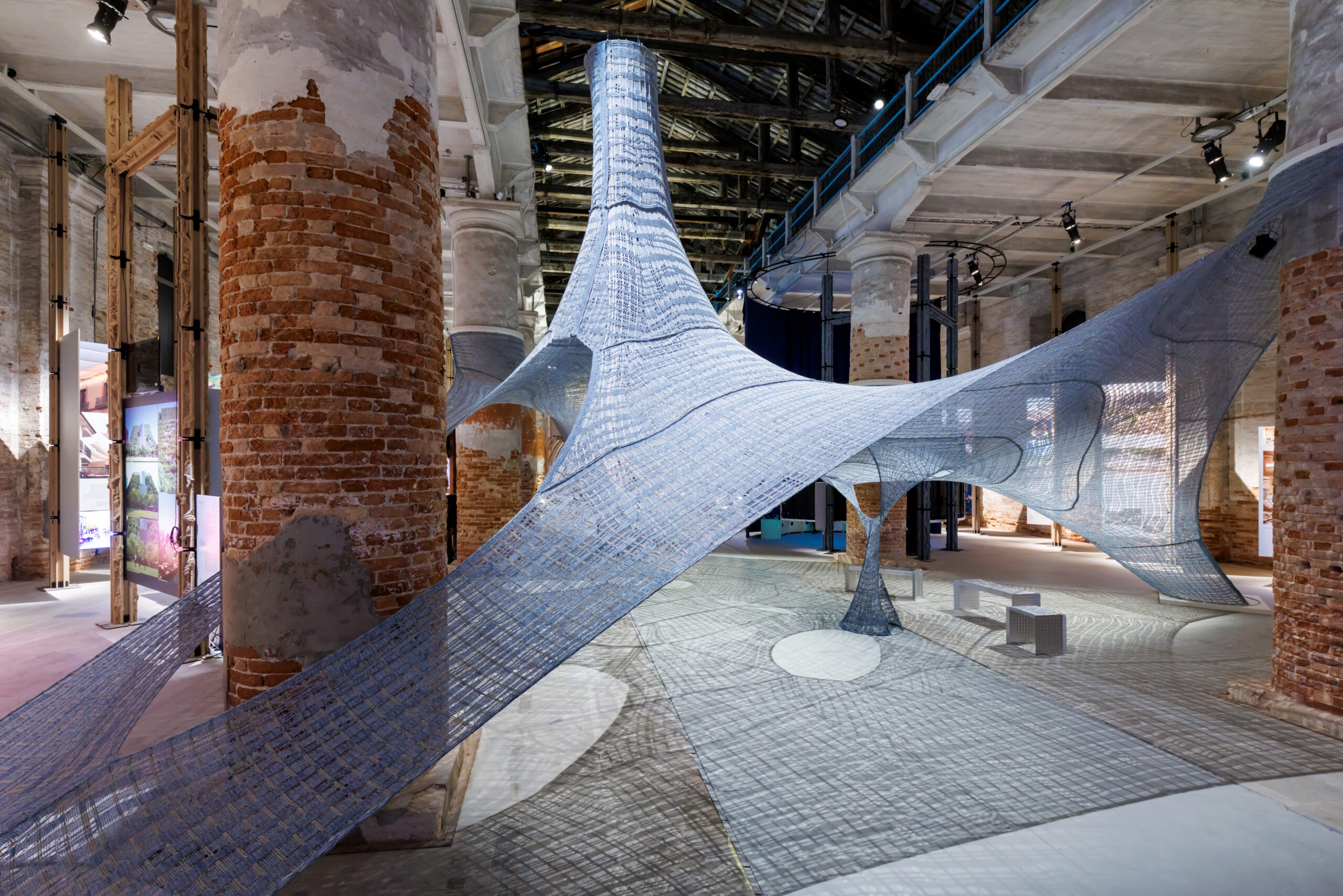Necto’s flowing anticlastic surface adapts fluidly, suspended from above, braced against the Arsenale’s columns, or anchored to the ground. Within its undulating geometry emerge three distinct architectural moments: an enveloping cone, a disorienting column, and a hanging mass.
Making of video
Expression

Facts and Figures
95%
biodegradable
100m2
textile surface
12
pieces of knit
40
hours to knit
38.5kg
total weight
10.9PB
DNA material passport
23
programmed LED strips
Features
Light footprint
The majority of materials are lightweight and portable, transported to the Arsenale as luggage via vehicle, commercial passenger flight, and vaporetto without crates or excess waste. The stone footings were sourced from second-choice slabs and delivered by vehicle from nearby Vicenza. At the exhibition’s end, Necto dissolves, leaving no trace—its surface flattened and packed, ready to embark on its next iteration.
Performative and fabrication-aware design
The geometry is form-found accounting for internal stress distribution, fabrication constraints, and material properties, with the aim of enhancing the spatial experience. It is developed through computational structural design and optimisation techniques, and fabricated using CNC knitting machines with natural fibres. Functional grading aligns with principal force flows. The two principle stress directions are materialised as flax fibre inlays in one direction and density variations within the knit architecture in the other. The entire patterning is computationally controlled through fabrication pipelines that automatically generate code for the industrial knitting machines to produce.
Experience design
Luminous threads seamlessly integrated within the textile follow selected stress pathways, forming a constellation of light and spatialized sound. Immersive animations dance across the membrane, transforming the structure temporarily into different environments, only to disappear entirely in the next moment again. The generative light and sound animations embrace lightness, exploring the expressive possibilities of a very minimal visual and sonic palette. Each atmosphere playfully speculates on the tensions between craft and algorithm, nature and technology, emergent process and design intent.
Material Intelligence & Circularity

95% of materials such as linen, flax and PVA are locally sourced and biodegradable. The textile’s water-soluble bio-based coating contains digital information encoded on synthetic DNA, borrowing from the expertise of 4 billion years of evolution. The data includes a material passport for all components used and machine instructions to produce the textile. Due to the nature of the DNA, this information will stay intact and part of the structure for its entire lifecycle, ensuring future traceability and accountability. Once the exhibition ends, its coating can be completely dissolved, and the textile can be easily and compactly packed in hand luggage and transported to its next destination.
Furniture – reclaimed aluminium benches

Two Pressure benches and one stool, designed and fabricated by Tim Teven Studio in Eindhoven from 2mm thick aluminium sheets, are positioned at the textile’s lower spans, allowing for moments of contemplation.
Credits
Design
SO – IL: Florian Idenburg, Jing Liu, Marlena Fauer, Demetri Lampris
Tailored Materiality Research (TU Delft/incoming MIT): Mariana Popescu
TheGreenEyl: Richard The
Membrane design and engineering
Tailored Materiality Research (TU Delft/incoming MIT): Mariana Popescu, Valentin Lorenzen da Silva, Niclas Brandt, Nikoletta Christidi
Experience design
TheGreenEyl: Richard The (creative director), Ben Bojko (software lead), Noah Feehan (hardware lead), Saralee Sittigaroon (architectural designer), Arden Schager (creative technologist), Ardak Mukanova (designer)
Structural Engineering
Professorship of Structural Design (TUM): Anass Kariouh, Pierluigi D’Acunto
Membrane fabrication and construction
Tailored Materiality Research (TU Delft/incoming MIT):Mariana Popescu, Nikoletta Christidi
Steiger Participation S.A: Jean-Luc Lepieszko, Jean-Francois Cochez
Bio-coating and DNA data embedding and error correction
Shaping Matter Lab (TU Delft): Kunal Masania, Jasper Groen
Functional Materials Laboratory (ETH): Robert Grass, Francesca Granito
Professorship of Machine Learning (TUM): Reinhard Heckel, Maria Abu Sini
Sound Design
Marian Mentrup
Furniture
Tim Teven Studio
Opening Performance
Riley Watts

